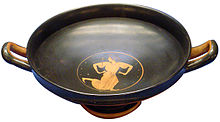- Kylix (drinking cup)
-
For other uses, see Kylix (disambiguation).
A kylix (or cylix, pl.: kylixes or kylikes; Ancient Greek: κύλιξ, pl.. κύλικες) is a type of wine-drinking glass with a broad relatively shallow body raised on a stem from a foot and usually with two horizontal handles disposed symmetrically. The almost flat interior circle on the interior base of the cup, called the tondo, was the primary surface for painted decoration in the Black-figure or Red-figure styles of the 6th and 5th century BC. As the representations would be covered with wine, the scenes would only be revealed in stages as the wine was drained. They were often designed with this in mind, with scenes created so that they would surprise or titillate the drinker as they were revealed. The word comes from the Greek kylix "cup," which is cognate with Latin calix, the source of the English word "chalice."
Contents
Formation
Kylixes were most popular during the Mycenaean times of the classic Athenian period of Ancient Greece.[1] They were created from the collection of earthenware, which ultimately aided in the production of the ceramic glass of the kylix.[2] Terracotta proved a popular substance in the production. A type of terracotta called "redware" was especially prized by the Greeks and Etruscans for its concentration of ferrous oxide giving it a red color.[3] After the kylixes were formed, an artisan drew a depiction of an event from Greek mythology or everyday life with a diluted glaze[4] on the outer surface of the formation.
Inside the drinking bowl was often a portrait of dancing and/or festive drinking.[1] Unique compositional skills were necessary for the artisans to attain due to the lack of verticals and horizontals on the surface. Onesimos, Makron, and Douris were famous painters in this field, renowned for their works.[5]
The bowl held roughly 8 oz/100ml of fluid.[6]
Purpose
Because the primary use for the kylix was at a symposium - a "drinking party" - in the ancient Greek world, they are often decorated with scenes of a humorous, light-hearted, or sexual nature that would only become visible when the cup was drained. Dionysos, the god of wine, and his satyrs or related komastic scenes, are common subjects. Scenes of heterosexual or homosexual love, sex or orgies are also often depicted. The shape of the kylix enabled the drinker to drink whilst recumbent, as was the case in the symposia.[1]
See also
References
- ^ a b c Allen, Douglas. Attic Red-Figure Kylix, Utah Museum of Fine Arts, 2008-02-19.
- ^ Young, Jenny. The Ceramic Art: A Compendium of the History and Manufacture of Pottery and Porcelain, Harper, 1878
- ^ Austin, Jamie. Terracotta: The beauty of fired earth, Part I, LifeInItaly.com, Retrieved on 2008-03-18.
- ^ Timeline of Art History, The Metropolitan Museum of Art, Retrieved on 2008-03-18.
- ^ Ancient Greek Pottery, Young Aggressive Sincere Organized and United, 2005-01-10.
- ^ [1]
Pottery of ancient Greece Wine shapes Perfume shapes and wedding shapes Funerary shapes and cultic shapes Storage shapes Techniques Painters Special topics in Greek pottery Typology · Kalos inscription · Symposium · Corpus Vasorum Antiquorum · John Beazley · Panathenaic Amphorae · South ItalianCategories:- Ancient Greek pot shapes
- Wine accessories
- Drinkware
- Ancient Greek cuisine
- History of wine
Wikimedia Foundation. 2010.

